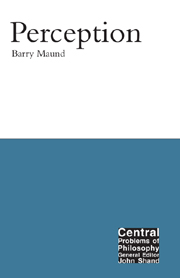Book contents
- Frontmatter
- Contents
- Preface
- 1 The philosophy of perception
- 2 A theory of natural realism
- 3 Theories of perceptual experiences
- 4 Representationalism: representations as natural signs
- 5 Natural realism: Putnam, Austin and Heidegger
- 6 Perception: the argument from illusion
- 7 The phenomenal and phenomenological senses of “looks”
- 8 Types of perceptual content
- 9 The representationalist–intentionalist thesis
- 10 Adverbialist accounts of perceptual experience
- Conclusion
- Notes
- References
- Index
8 - Types of perceptual content
- Frontmatter
- Contents
- Preface
- 1 The philosophy of perception
- 2 A theory of natural realism
- 3 Theories of perceptual experiences
- 4 Representationalism: representations as natural signs
- 5 Natural realism: Putnam, Austin and Heidegger
- 6 Perception: the argument from illusion
- 7 The phenomenal and phenomenological senses of “looks”
- 8 Types of perceptual content
- 9 The representationalist–intentionalist thesis
- 10 Adverbialist accounts of perceptual experience
- Conclusion
- Notes
- References
- Index
Summary
When we perceive a physical object we have a perceptual experience caused by that object. It is common to hold that such experiences have two aspects: a sensuous, sensory aspect and an intentional aspect. The experience is intentional in the sense that it carries intentional content: it represents (things in the world) as being a certain way. A perceptual experience is typically an experience that represents a cup before me, a tree through the window, a police siren heard in the distance, the burning toast in the kitchen and so on. It is commonly held that besides having intentional content, the perceptual experiences have a sensuous, sensory aspect: there is something to the taste of a Shiraz wine, the smell of burning onions, the look of a Perth blue sky, that is not captured in the intentional content.
The difference between the intentional and sensory aspects of perceptual experience is reflected in the different senses of “looks”, “tastes” and so on. As I argued in Chapter 7, there is a perfectly ordinary phenomenological use of “looks”, one that is intentional and conceptual. There is, however, a more technical, phenomenal sense of “looks”. This use depends on the fact that the ordinary phenomenological use depends on there being a descriptive, non-conceptual way in which things look.
When, therefore, we report on how things look to us, in the sense of reporting “how things strike me”, we are describing our perceptual experiences.
- Type
- Chapter
- Information
- Perception , pp. 149 - 164Publisher: Acumen PublishingPrint publication year: 2002



